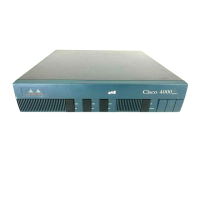6 Cisco 4000 Series Hardware Installation and Maintenance
G
general site requirements 2-3
H
h command (help, in bootstrap) C-2
hardware, reinitialize C-2
help command D-2
humidity, specifications 1-3
I
i command (initialize and reboot) C-2
IEEE
802.3 AUI connector 2-10
serial line distance limitations 2-15
ignore NVRAM contents C-3
indications
dual serial LEDs 4-7
FDDI, ring up 4-9
ring speed 4-5
Token Ring LEDs 4-5
inspecting the system 2-36
installation
checklist 2-5
preparing for 2-1
tools required 2-6
installing
Cisco 4000-M boot ROMs 5-19
network processor modules 5-20
router 3-1
shared-memory SIMMs 5-13
system-memory SIMMs 5-8
Integrated Services Digital Network
See ISDN
interface pinouts
BRI 3-8, A-22
EIA/TIA-232, dual-port A-4
EIA/TIA-232, four-port A-5
EIA/TIA-449, dual-port A-7
EIA/TIA-449, four-port A-8
EIA-530, dual-port A-16
EIA-530, four-port A-18
V.35, dual-port A-10
V.35, four-port A-11
X.21, dual-port A-14
X.21, four-port A-15
interference, considerations 2-18
internal components, accessing 5-1
ISDN
BRI port 3-6
CSU/DSU 3-6
J
jumper settings
Flash memory 5-7, 5-8
NRZ 2-21
NRZI 2-21
K
k command (display stack trace) C-2
key, Break (interrupt) C-1, D-1
L
LED indications
Ethernet 4-4
FDDI 4-9
front panel 4-3
network processor modules 4-4
serial 4-8
Token Ring 4-5
lightning
damage 2-4
storm, safety during 2-3
link, Ethernet LED 4-5
loading software from Flash B-6
log, site 2-6
M
maintenance, system 5-1
making connections
auxiliary port 2-9
console port 3-1
Ethernet 2-10, 3-3
FDDI 2-25, 3-11
final 3-22
network 3-2
optical bypass switch 2-28, 3-13
serial 2-19, 3-4, 3-5
Token Ring 2-14, 3-2
media-type command 2-10, 4-4
meminfo command D-4
memory
adding
shared-memory SIMMs 5-13
system-memory SIMMs 5-8

